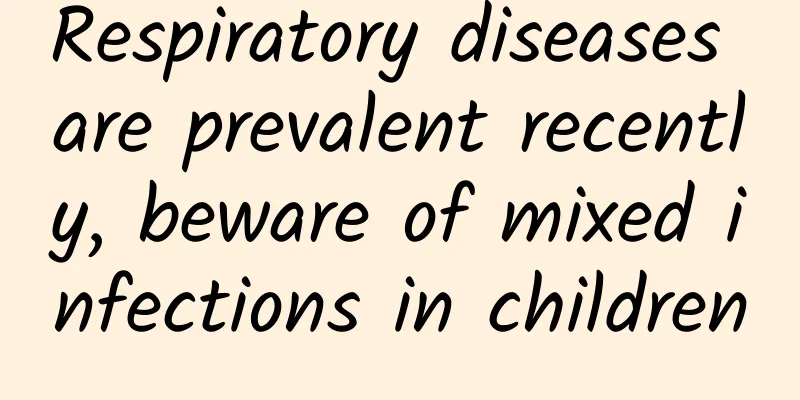Respiratory diseases are prevalent recently, beware of mixed infections in children

|
Respiratory diseases are prevalent recently, beware of mixed infections in children Duchang County Center for Disease Control and Prevention 2023-11-08 11:16 Published in Jiangxi This autumn, the incidence of respiratory diseases has increased in various places. The China Influenza Monitoring Weekly Report released by the China National Influenza Center shows that the positive rate of influenza virus detection in southern provinces continues to rise, and influenza activity in some northern provinces has increased slightly; however, there are more mixed infections such as new crown, influenza, respiratory syncytial virus, and Mycoplasma pneumoniae. The new version of the influenza vaccination technical guide also pointed out that this winter and next spring, my country may face the risk of interaction or co-epidemic of multiple respiratory infectious diseases such as influenza. In late autumn, the temperature changes are complex, the climate is dry, and the temperature and humidity vary greatly. Under the stimulation of constant warm and cold, the respiratory mucosa is dysfunctional and the resistance is reduced, making autumn a high-incidence season for respiratory diseases. Children's immune systems are not yet fully developed, and their respiratory tracts are more susceptible to the influence of temperature and humidity. The probability of virus infection will be higher and the duration of continuous infection will be longer. In order to protect children's health and protect their healthy growth, corresponding prevention strategies should be formulated for this high incidence of mixed infection respiratory diseases. Common respiratory infections in children 1. Influenza Influenza (abbreviated as "flu") is an acute respiratory infectious disease caused by influenza virus. Influenza virus can be divided into four types: A, B, C, and D. The main strains of influenza seasonally prevalent in my country are A and B, and most of the pandemics are caused by influenza A virus. This year, the H3N2 subtype of influenza A is the main one, and it is co-prevalent with the Victoria strain of influenza B. The incubation period of influenza virus is generally about 1 week. It is mainly transmitted through respiratory droplets produced by sneezing and coughing of the infected person, and can also be directly or indirectly infected through mucous membranes such as the mouth, nose, and eyes; in specific places, such as crowded, closed or poorly ventilated rooms, it may also be transmitted in the form of aerosols. The main manifestations are acute onset, high fever, chills, headache, muscle and joint pain, general fatigue, nasal congestion, sore throat and dry cough. A small number of patients may have digestive symptoms such as nausea, vomiting, and diarrhea. The influenza infection rate is highest among children and decreases with age. About 20% to 40% of symptomatic children may experience influenza-like symptoms (fever, cough or sore throat), while up to half of symptomatic people may experience acute upper respiratory tract symptoms without fever, and the proportion of asymptomatic people can range from 14% to more than 50%. Children under the age of 5 are prone to severe illness and even death when infected with influenza, and the risk of death for children with underlying diseases is even higher than that of healthy children. 2. Respiratory syncytial virus Respiratory syncytial virus is an RNA virus belonging to the family Paramyxoviridae. It has only one serotype, which is divided into two subtypes, A and B. Currently, the ON1 genotype of subtype A and the BA9 genotype of subtype B are the dominant genotypes prevalent worldwide, and are also the main genotypes prevalent in my country in recent years. Its main transmission routes are also contact transmission and droplet transmission. The incubation period is usually 3 to 7 days, and it is highly contagious. There may be high fever, rhinitis, pharyngitis and laryngitis, followed by bronchiolitis and pneumonia; a small number of children may have complications such as otitis media, pleurisy and myocarditis; after infection, older children mainly show upper respiratory tract infections. For children, syncytial virus and influenza are easy to attack together. In previous years, respiratory syncytial virus mostly occurred in children under 2 years old, but this year, infections in older children have increased. 3. Mycoplasma pneumoniae Mycoplasma pneumonia is a lung inflammation caused by infection with Mycoplasma pneumoniae. It is the most common community-acquired pneumonia in children aged 5 years and above in my country. The incubation period of Mycoplasma pneumonia is about 1 to 3 weeks. It is contagious from the incubation period to the relief of symptoms for several weeks. When the patient is in a sick state, Mycoplasma pneumoniae is easily exhaled from the respiratory tract and spread through droplets, causing the spread of the disease. The symptoms of Mycoplasma pneumonia infection are similar to those of most respiratory diseases, with fever and cough as the main symptoms. They are generally paroxysmal and the cough is more severe. The cough may continue for 1 to 2 weeks after the fever subsides. In the early stage, the child has an irritating dry cough. In the later stage, with the discharge of airway secretions, there will be sputum. 4. Novel coronavirus infection Novel coronavirus infection is an acute infectious disease caused by a novel coronavirus. It is a Class B infectious disease in my country. In 2020, the "Class B A Management" will be implemented. As the toxicity of the mutant strain weakens, the "Class B B Management" will be implemented in 2023. The incubation period of the new crown is generally 1 to 14 days, mostly 3 to 7 days, and it is also contagious during the incubation period. It is highly contagious within 5 days after onset. It is mainly transmitted by droplets, contact, aerosols, etc. The main manifestations are fever, dry cough, and fatigue; some patients have nasal congestion, runny nose, sore throat, decreased or loss of smell and taste, conjunctivitis, myalgia, and diarrhea. People are generally susceptible to the new coronavirus. Clinical manifestations of mixed respiratory tract infection This year, respiratory infectious diseases have interacted in many places. Many children have been infected with multiple respiratory viruses at the same time or successively, or have been infected with mycoplasma when infected with respiratory viruses. These children usually have poor physical constitution and low immunity, and their condition will be relatively serious when mixed infections occur. Common symptoms of respiratory infections include sneezing, runny nose, nasal congestion, nasal burning, coughing, sputum, dyspnea, wheezing, sore throat, swollen tonsils and lymph nodes, etc. In severe cases, respiratory failure and septic shock may occur. Systemic symptoms may include headache, fever, fatigue, muscle aches, nausea and vomiting. When various respiratory pathogens are mixed, the symptoms they cause are difficult to distinguish, and the mixed infection rate with other respiratory pathogens varies from region to region and sampling period. Prevention and control strategies for mixed infections of respiratory diseases 1. Wearing a mask scientifically is one of the best protective measures against respiratory infectious diseases Situations or scenarios where you should wear a mask: during epidemics of respiratory infectious diseases; when you have symptoms of respiratory virus or microbial infection such as fever, sore throat, cough, runny nose, muscle aches, fatigue, etc.; when there is an outbreak in the community or school where you live or study; when you go to a medical institution. Situations or scenarios where wearing a mask is recommended: when taking public transportation; when entering closed and crowded places such as supermarkets and theaters. Situations or scenes where you don't need to wear a mask (not during an epidemic of respiratory infectious diseases and if you are in good health): outdoor places such as open squares and parks; places where there are relatively fixed people around you (such as when teachers and students are in school); and during exercise. 2. Parents and children should maintain good hygiene habits and hygiene etiquette Adhere to good hygiene habits such as frequent hand washing, frequent ventilation, the use of public chopsticks, maintaining social distance, coughing etiquette, cleaning and disinfection, and a healthy lifestyle such as a reasonable diet and moderate exercise, and consciously improve health literacy and self-protection capabilities; reduce gatherings and avoid going to crowded places. 3. Schools are key places for preventing respiratory infectious diseases Primary and secondary schools should ensure daily ventilation, cleaning and disinfection of classrooms, public living areas and other places, and place public disinfection supplies at the entrances of school buildings, stairs, elevators and other places for daily self-disinfection of teachers and students. Primary and secondary schools should report any infection to their superiors and health departments as soon as possible, based on the class. Kindergartens and parents should jointly monitor the health of children and ensure that they are sent to kindergarten only when they are healthy. Primary and secondary schools and kindergartens set up health observation rooms for teachers and students to provide temporary observation rooms for teachers and students with symptoms such as fever, and guide parents to safely take students and children home. Primary and secondary schools and kindergartens should strengthen health monitoring of teachers and students, implement morning and afternoon medical examinations, infectious disease epidemic reporting systems, and sickness absenteeism tracking and registration systems, establish an electronic ledger of student health information, and improve the level of disease monitoring and early warning informationization. 4. Currently, in terms of vaccination, except for the COVID-19 and influenza vaccines, there are no other effective vaccines on the market. Because the XBB variant of the novel coronavirus is the main strain in this autumn and winter, vaccines containing the antigen components of the XBB variant are recommended as a priority. All groups can be vaccinated according to the recommendations of relevant documents, with the target population receiving enhanced immunization and the non-target population receiving basic immunization. Usually, protective antibodies are produced 2 to 4 weeks after influenza vaccination, and the antibodies reach a peak after 1 month. The best time for influenza vaccination is recommended to be from September to November each year. If you miss the best time, you can still get vaccinated throughout the epidemic season. The target population for influenza vaccination is people 6 months of age and above. The influenza virus mutates every year, and the protective effect of the vaccine is only 6 to 8 months, so new vaccines need to be re-administered every year. In addition, key places such as childcare institutions, primary and secondary schools should not only ensure that students are vaccinated, but also prioritize school staff for influenza vaccination. |
>>: "The King of Cancer" Why is pancreatic cancer so dangerous?
Recommend
Can babies take hormone drugs?
Review of the hormone cream incident: After a par...
Can pregnant women enjoy natural breeze?
After giving birth, there are many things to pay ...
What to do if the car window film bubbles up? Why can't you open the window after applying the car window film?
Nowadays, many car windows will choose to apply f...
Small acne pictures on the areola
Normal women's nipples should be relatively s...
How to conceive a boy
Although the idea of favoring boys over girls i...
Pregnant women sleep late and don't eat breakfast
When a woman becomes pregnant, her body will unde...
One month pregnant belly bulge
Generally, a woman's belly will not become no...
How to treat uterine prolapse?
What is the most common disease among women that ...
When should minor fetal abnormalities be screened?
Minor fetal malformation screening is a method of...
Can I get pregnant again after three abortions?
Medical abortion is not completely safe. The proc...
Menstruation suddenly comes seven or eight days early
The problem of early menstruation makes many wome...
"Three Reds and Three Blacks" are the secrets of women's eternal youth
Wolfberry Although wolfberry has good nourishing ...
How long after giving birth can I hold my baby?
A baby is the fruit of parents' efforts and i...
Where is Fenghuang Ancient Town? What is the temperature in Fenghuang Ancient Town in May?
Fenghuang Ancient Town was built in the 35th year...
Normal values of three thyroid function tests during pregnancy
During pregnancy, some of the thyroid hormone nee...









